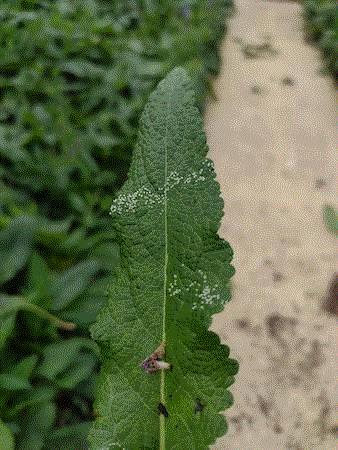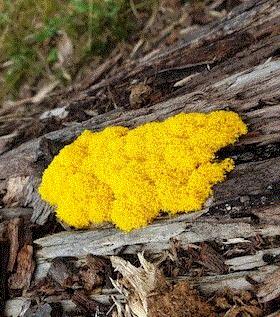Recent Hurricanes
I can’t believe that Florida has been hit with two major hurricanes in just as many weeks. I’d like to extend my heartfelt concern and support to our subscribers and anyone in our industry and their family and friends who've been affected by Hurricanes Helene and Milton.
If you’ve been impacted by these storms and need assistance, there are a number of agencies and disaster programs that can help to get your business repaired and back up and running. By no means is this a complete list, but here are some good starting points:
What’s Happening Here?
This is an interesting challenge I received from a grower and newsletter subscriber. At the time, the grower didn’t know what was occurring on their salvia and reached out to me to see if I’d seen it before. The good news is that I have seen this problem before. Have you?
After a period of rain, this grower observed patches of what resemble eggs on some of their salvia. Was the sudden appearance of these "egg masses" coincidental with the recent rainfall or did the rain influence the development of them?
Please allow me to turn these questions over to you. Do you know what they are? Are they eggs, fungal growth or some other mystery? It’s time for me to ask, “What’s happening here?”
Stay tuned—I’ll reveal the answer at the end of the newsletter.
Molinia Dark Beauty
Molinia Dark Beauty is a recent introduction from
Future Plants. This exciting new moor grass was discovered by the famous designer Piet Oudolf in his famous Hummelo garden. Dark Beauty produces dense arching tufts of deep green foliage. The flowers are held nicely on dark stems and panicles, blooming in mid to late summer. Dark Beauty reaches 6-ft. tall when flowering and turns straw color in the fall. This warm-season grass is a good performer, is strong and sturdy, and has a tall, elegant airy structure. Hardy to at least Zone 4.
Primula Prettty Polly Blushing Peach
Blushing Peach is one of four exciting new Primula Pretty Polly cultivars Pacific Plug & Liner (
PP&L) recently added to their perennial portfolio. Like all the varieties in the series, Blushing Peach is renowned for its distinctive double flowers, which sets this series apart from other
Primula polyanthus cultivars on the market.
Blushing Peach produces bicolor pale yellow blooms with layers of petals that are edged in pink. It grows 6 to 8 in. across and produces amazing double flowers atop sturdy 12-in. stems. Hardy to Zone 4.
Our Future is Bright
A recent study is showing that enrollment in horticulture programs is at a 10-year high. I saw the announcement when it came out and recently read Chris Beytes' coverage of this topic in the September 27 issue of Acres Online. Rather than reinventing the wheel or regurgitating the facts, I thought I’d pass along Chris’ article in its entirety.
If true, it’s both understandable and gratifying because we’ve been saying for several years now that the younger generations has as strong interest in growing food, saving forests, and even producing hemp and cannabis. So they should be signing up for horticulture programs.
And an enrollment survey conducted by North Carolina State University in collaboration with Seed Your Future indicates that they are. Bachelor’s program enrollment reached a 10-year high in 2021 and nearly half (47%) of universities surveyed in 2024 reported increased enrollment over the past five years. Two-year horticulture programs, which had faced a long period of decline, have also seen an uptick, particularly following the disruptions caused by the COVID pandemic.
John Dole, study co-author, noted, “It’s important to recognize that the rise in student numbers began before the pandemic, which further amplified interest in horticulture.”
Co-author Melinda Knuth added, “Looking at historical data helps us strategize for the future. The steady rise in female and Hispanic students over the last decade is promising, and as we move forward, it’s crucial to assess how well we are meeting the diverse needs of all students.”
The study also highlights an encouraging trend at four-year universities: more students are entering horticulture programs directly from high school rather than transferring in, signaling a deeper interest in the field among younger students.
Among bachelor’s degree programs, Colorado State University leads the nation in horticulture enrollment, followed by Cal Poly-San Luis Obispo, Oregon State University, Texas Tech and Washington State University. For associate degrees, Pennsylvania State University had the highest enrollment in 2021, with Michigan State, NC State, Ohio State and the University of Massachusetts rounding out the top five. Regionally, the West boasted the highest number of horticulture students, followed by the South, Midwest and Northeast.
Jazmin Albarran, Director of Seed Your Future, shared her enthusiasm about the growing interest in horticultural careers. Since its founding in 2014, the organization has been committed to raising awareness and inspiring the next generation of horticulture professionals. Jazmin emphasized the need for continued industry engagement to sustain this momentum, noting that Seed Your Future has developed several initiatives aimed at reaching even more students.
Read the full College & University Enrollment Survey Report 2024 HERE.
Thank you, Chris, for compiling this article and for sharing it with both your subscribers and mine.
If for some reason, you’re not already familiar with
Acres Online, I encourage you to check out the latest newsletter
HERE, and if you like what you read, please
SUBSCRIBE—it's FREE!

The Answer is …

I shared this image at the top of the newsletter and asked if you knew what these dots that appeared on the salvia were. Do you think you figured it out? My clues above were they look like egg masses and they appeared following a rainy period.
These dots occurred on both the upper and lower leaf surfaces and over time the round structures turned brown. Do these additional clues help? It’s time to find out. I’m guessing most of you won't get this one correct, but let’s find out. If you answered the dots are a type of slime mold, you correctly solved this week’s challenge.
It’s What ...?
I’m guessing the answer to the challenge has taken many of you by surprise. If you’re familiar with slime molds you’re likely thinking of its vomit-like appearance on the surface of mulches.
 Slime mold on mulch.
Slime mold on mulch.
Before posting this challenge, I shared the images with Dr. Janna Beckerman, Ornamentals Technical Specialist at Envu, and although she prefers to use a microscope for confirmation, she was confident the dots on the salvia are a type of slime mold (Physarum).
What are slime molds?
Taxonomically, slime molds seem simple, but they're actually complex. One thing I can offer is they aren't fungi. Janna explained, “As a group of organisms, slime molds possess both animal and fungal-like characteristics, but are currently residing as their own group called Mycetozoa, distinct from fungi, animals and plants.”
There are two main groups of slime molds: the cellular slime molds (Arasiomycetes), which consists of approximately 70 known species; and plasmodial or true slime molds (Myxomycetes) of which there are over 1,000 species.
|

“Scrambled eggs” slime mold.
|
“Dog vomit” slime mold. Notice it started on the mulch and then moved up onto the holly.
|
Slime molds commonly occur on the surface of mulches, decaying logs, fallen leaves, lawns and occasionally on plants. They typically occur during or immediately following periods of warm, moist conditions.
Slime molds are harmless to most plants, pets and for the most part humans (individuals with respiratory conditions could possibly be irritated by the spores).
Since slime molds aren't actually fungi, fungicides aren't effective at controlling them. Unfortunately, there are no effective management strategies.
Janna said, “The worst thing you can do is spray them with water (or fungicides), which allows them to spread.”
Since they don't attack healthy plants or cause injury to them, it’s best to let nature run its course and they'll dry up and disappear unless moist conditions persist.



Thanks for reading this edition of Perennial Pulse. My email is paul@opelgrowers.com if you have any comments, article suggestions or if you'd just like to say hello.
Best regards,

Paul Pilon
Editor-at-Large—Perennial Pulse
Director of Growing—Opel Growers
This email was received by you and 34,429 other fine subscribers!
If you're interested in advertising in Perennial Pulse, contact Kim Brown ASAP and she'll hook you up.